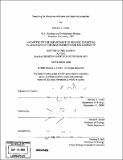Searching for ribozymes with new and improved properties
Author(s)
Curtis, Edward A. (Edward Arthur)
DownloadFull printable version (11.99Mb)
Other Contributors
Massachusetts Institute of Technology. Dept. of Biology.
Advisor
David P. Bartel.
Terms of use
Metadata
Show full item recordAbstract
The technique of in vitro selection was used to learn more about the properties of RNA sequence space. In Chapter 1 I investigated how readily ribozymes with new catalytic activities and folds could arise from an existing ribozyme scaffold. In vitro selection was used to isolate 23 kinase ribozymes from a pool of more than 104 variants of an aminoacylase parent ribozyme. The density of kinase ribozymes in the pool increased dramatically as the mutational distance from the starting ribozyme increased, suggesting a need to escape the fold of the parent. Consistent with this idea, the folds of two kinases characterized in detail were different from that of the starting aminoacylase scaffold. In Chapter 2 I1 investigated the extent to which one of these kinase ribozymes could be optimized using a method of recombination called synthetic shuffling. Point mutations from previously isolated sequence variants of this ribozyme were shuffled in more than 1014 different combinations, and active variants isolated by in vitro selection. The rate of the most efficient ribozyme identified was 30-fold faster than that of the most efficient ribozyme used to build the pool, with a second order rate enhancement approaching 100°- fold. (cont.) Further analysis revealed two groups of mutations, derived from two different ribozymes used to build the shuffled pool, that each increased the rate of the ribozyme by approximately 30-fold. The effects of these mutations were independent of one another, and when combined produced a ribozyme with a rate 600-fold faster than that of the initial isolate. Together, these experiments provide insight into how RNA sequence space can be searched for ribozymes with new and improved properties.
Description
Thesis (Ph. D.)--Massachusetts Institute of Technology, Dept. of Biology, 2006. Includes bibliographical references.
Date issued
2006Department
Massachusetts Institute of Technology. Department of BiologyPublisher
Massachusetts Institute of Technology
Keywords
Biology.